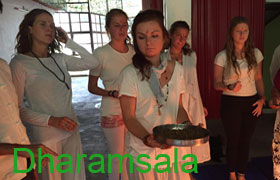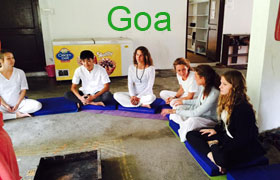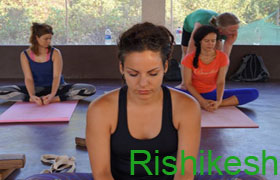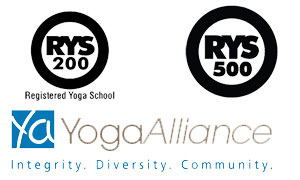Ashtanga Pranayama and Ashtanga Yogasana
Ashtanga Pranayama
Ashtanga Pranayama in general is not taught to a student until he has at least mastered the advanced postures. In other words pranayama is not advisable to be practiced unless the student has mastered a fine grip over asanas. The traditionally taught Ashtanga pranayama is quite different and tougher to practice than the gentler pranayama practices taught usually. Longer inhalation and exhalation and breath retention needs completely stable body and mind. When the entire system of nadis that is filled with impurities is being cleaned, the yoga shall become capable of controlling the prana. This process takes a gradual practice similar to taming wild animals like lions which would otherwise kill the practitioner himself.
Trying to learn pranayama through a book is not at all a good idea. Pranayama should be strictly practiced under the guidance of a teacher as the science of pranayama is physically challenging. The ratios of breath retention, inhalation, exhalation and the numerical progression involved in the practice should be mastered thoroughly. An individual indeed cannot get across the verge of life and death casually and so one who rushes to make a premature attempt to surpass it, does so at their own peril. All the abilities attained in a life, for that matter everything that is achieved in a life is nothing compared to the realization of the self. Thus, one should rather focus on the process than on the goal.
According to Krishnamacharya Savasana is a practice of being dead, which is highly mystical and dangerous process. He described it as the ability to stall the heartbeat. This ability develops as a result of regular practice of pranayama. However, it is not the final goal to be achieved. Thus Ashtanga pranayama is analyzed in this viewpoint. It is practiced only once the aspirant is ready which may never even happen in his life.
Ashtanga Yogasana
The asanas or the yoga postures form the second aspect of tristhanam or in other words the body aspect. Although, the conventional methodology of learning Ashtanga yogasanas begin equally with mind along with the body. It means both mind and body are equally involved in it. When a beginner starts learning suryanamskara, he or she will continue the practice until they memorize all the asanas in the sequence to follow. This information tends to be stored in body memory rather than intellectual memory. Self practice begins from the very first class of the beginning. It does not at all matter how well the individual practices it in physical terms. Judging based on appearance is not at all important. Memorizing forms the most vital part of it. This poses to be a tougher challenge for a starter than doing it physically well.
Following the practice of suryanamaskara, the student will be taught one or two standing asanas after which the student shall sit down and try out a few versions of Padmasana and then lifts upwards in Utpluthihih. This practice will be finished within half an hour. One posture is added in sequence each day for the student to learn. This is called the traditional Mysore method. It is mandatory to practice Utpluthihih at the end of each practice, irrespective of the length of the time spent on it. Essentially, the student should be able to remember the particulars of whatever has been taught before moving on to the next postures.
However, this is not the only way to teach Ashtanga yoga. In general, most of the students are encouraged to attend the led classes for a few years in the beginning in order to get accustomed physically. Nevertheless, self practice is the best method to be adapted by a fresher to aid the student to remember. The slower the practice the deeper it has its impact. Hence it is always helpful to teach at a slow pace instead of rushing through all the postures at once.
Apart from this repetition plays key role in memorizing. As the student tends to pick up the sequence there would be a corresponding improvement in the trust level of the body because the student knows what he is doing and what he would be doing next. The anxiety involved with the anticipation of the next posture is absolutely absent. The physical aspect tends to gradually develop along with increased strength and flexibility as the body starts to synchronize with the mind. Focusing on the practice rather than the outcome plays a major role.
The consistent practice of the primary sequence for a certain amount of time will enable the student to learn the intermediate level postures. These asanas will be added to the practice one per day. As the practice gets longer eventually the student may skip the primary level asanas and practice only the intermediate asanas. This is termed as splitting the practice wherein the sequence of the asanas related to a certain level only are practiced. Same procedure is followed while learning the advanced asanas too.




